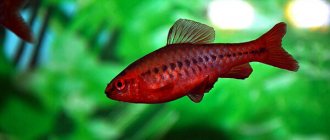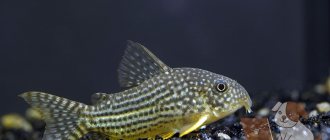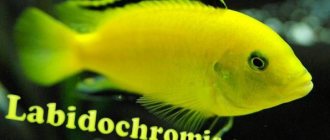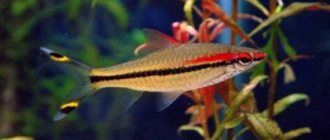Many aquarists believe that this cute fish has an obnoxious character. She is often, and sometimes quite deservedly, called a real striped robber. The Sumatran barb, the photo of which is posted in the article, is bred by both experienced connoisseurs of the beauty of the underwater world and novice amateurs. This popularity is explained by the fact that it is very interesting to watch these restless fish that rush around the aquarium and, at the slightest opportunity, catch their neighbors.
The Sumatran barb is a schooling, beautiful fish that lives in freshwater reservoirs in southeast Asia. As a rule, they are bought in a flock of up to 20 individuals. Later, pairs are selected from them and the fry are bred. How does this happen? How to distinguish a female from a male Sumatran barb? More on this later in the article.
How to distinguish a female from a male
The external differences between male and female producers are the intensity of color and size. The male barb is smaller in size and will be brighter in color. In females, the abdomen stands out and the color will be pale.
You can find out the gender of the spawners by their pectoral fins. The male's fins are bright orange, while the female's are closer to a red hue. The male has orange stripes on the caudal and dorsal fins, but the females do not have such stripes.
Description of the species
These schooling fish have a memorable color and appearance: a golden-yellow or silver body with tightly fitting gills intersected by black vertical stripes of medium width. The body of the Sumatran is quite high, slightly flattened laterally.
The back of the fish is painted in a darker color, having a reddish tint, and the belly is yellow-white. A characteristic feature of this species can be considered four vertical black stripes. The first one passes through the eye of the fish, the second - behind the pectoral fin, the third - behind the dorsal fin, the fourth - at the base of the tail.
The triangular-shaped dorsal fin is quite high, it is colored black with a thin red border. Other fins are red or pink. Small barbs, which reach seven centimeters when kept in an aquarium, live about four years with proper maintenance and proper nutrition, although cases of higher rates have been recorded. To keep a group of barbs you will need an aquarium with a volume of at least 30 liters.
Preparing barbs for reproduction
Preparation of the female and male begins with their placement in separate tanks. This must be done two weeks before spawning. During the entire preparation period, males are fed abundantly; it is recommended to give a lot of live, protein food.
During the period of spawning preparation, the behavior of the fish is carefully monitored so as not to miss the moment of transferring the female and male into the spawning tank. If you keep a female in a sump, she may get sick, which will lead to her death. Males become aggressive when overexposed.
You can find out about the readiness of viviparous breeders for spawning by the size of the genitals. The female has a strongly protruding abdomen, which is filled with eggs, and spawning males secrete milk.
Sexual dimorphism
Barbs are aquarium fish that are valued for their bright colors. Also among representatives of this species there are albinos and mutant forms with a green color. Such fish are highly valued.
Sexual dimorphism of barbs using the example of Sumatran fish.
Sexual differences, or dimorphism, are very weakly expressed in barbs. Until barbs reach the age of puberty, it is almost impossible to distinguish a female from a male. At the age of one year, the appearance of the fish changes so much that males and females can be distinguished.
Boys are usually smaller in size. During the mating season, the fish's nose becomes bright red.
The female barb itself is larger in size and has smoother contours, and before spawning, its belly becomes more voluminous due to the eggs. The nostrils of females are slightly lighter than those of males. Females are not as brightly colored as males.
Barbs are cannibals and can eat both eggs and fry. In order to ensure the survival of the fry, adult fish should be removed from the eggs immediately after spawning.
Puberty
Readiness to breed offspring occurs at the age of 5 to 9 months. Females develop much faster and are ready to reproduce a month and a half earlier.
The shark baloo or shark barb reaches sexual maturity at the age of 1.5 years, which is why this species does not reproduce in amateur aquariums for a number of other reasons.
Over time, the rounded abdomen of the female becomes noticeable to the naked eye.
If eggs are ripe in the female's belly, her abdomen becomes swollen. This is a clear sign that she is ready to breed.
For spawning, the female with the largest belly is chosen. Among the suitors, the most active male with a bright color is chosen.
How to choose manufacturers
To breed barbs, it is enough to purchase six individuals and place them in a large aquarium. The ratio of males and females should be 1:2. During adaptation, dominant individuals appear in the quarantine tank. After observing the fish, it becomes noticeable that some males begin to court females. If several males are courting one girl, then the most beautiful one is chosen so that his genes are passed on to the offspring.
Preparing the spawning area
To breed barbs, a separate tank with a volume of 5-10 liters is required. A male and female barb are placed in the tank. Before introducing fish for spawning, it is necessary to disinfect the tank and then start arranging it.
The tank is filled with water to a depth of only 25 cm for successful reproduction. The bottom is lined with a mesh with small cells through which the eggs can crawl. No soil is placed on the bottom of the spawning tank. The net protects the eggs from being eaten by the female or male. Some aquarists place Java moss or fern on the bottom, which protect the eggs from voracious parents.
Habitat
There are more than 20 species in nature. Some of them were on the verge of extinction, but thanks to the interest of aquarists and successful attempts to reproduce them in captivity, these fish were preserved. Natural habitat is the waters of Southeast Asia and Africa with a large number of thickets of aquatic plants near the shores and space for active swimming. Some species prefer colder water with current. Others, on the contrary, need a weak current and warm water. All this should be taken into account when arranging an aquarium.
Water for spawning
The water for the spawning tank is left to settle for three days. The water for spawning should be mixed: 70% tap water, and 30% distilled. The acidity of the water for the spawning tank should be low, no more than 6 pH. To prevent fish and offspring from the spread of infections, a drop of peat extract or a decoction of alder cones, as well as phosphoric acid, is added to the water. The water hardness in the spawning tank should not be higher than 2 dH. Barb fish spawn at a temperature of 25-28 degrees, so they put a heater and thermometer in the aquarium and monitor the temperature.
There should be an aerator in the spawning tank, since oxygen saturation of the water is a prerequisite for successful spawning. The aerator will work for three days after filling with water until the fish move into the spawning area.
General information
GloFish is a patented commercial name for genetically modified aquarium fish. It consists of two English words - “glow” (glow) and “fish” (fish), that is, literally “glowing fish”, which reflects the main property of these amazing creatures. In blue light or ultraviolet rays, glofish fish begin to fluoresce and “flare up” like bright lights. This became possible thanks to the introduction into the DNA of fish of genes from marine coelenterates (corals and jellyfish), which are responsible for the synthesis of fluorescent proteins. In blue light and UV rays, glofish zebrafish begin to fluoresce
Glofish fish appear and develop naturally from parents with a fluorescent gene, that is, it is inherited. The fish are not artificially colored or injected with paint! They are not sterile; when the necessary conditions are created, they reproduce without difficulty with the appearance of new bright offspring. Glofish fish are freshwater tropical species, the conditions of which do not differ from those of their natural relatives. A suitable aquarium volume, the necessary equipment, an established biological balance and regular maintenance will be the key to a long and healthy life for your glofish pets. They are perfect for keeping in community aquariums.
It is worth noting that fluorescence is a fairly common phenomenon in natural fish species. A study by the American Museum of Natural History has identified more than 180 species of fish in the wild from 50 families that fluoresce when exposed to blue light. In addition, a similar phenomenon is widely represented in many corals, some insects, spiders, and even flowering plants. That is, biological luminescence is only the ability of cells of living organisms to “accumulate” light and then release it, which is absolutely safe and has nothing to do with, for example, radiation.
Thus, apart from the bright, unusual coloring, the fish are absolutely no different from natural ones, but they allow you to create fantastic aquarium designs that will appeal to both amateurs and professionals.
As noted above, during the daytime, glofish fish absorb light and then re-emit it. Therefore, during the day, it is best to keep the fish under a lamp with a blue spectrum lamp - this is what gives them a stunning look, especially if there is dim lighting in the room where the aquarium is located. However, regular aquarium lamps with white light will also work and the glofish will still be able to “accumulate” light.
In the evening, it is most optimal to use only blue lamps (many modern lamps have a similar night lighting function). By placing different types of glofish in an aquarium and using suitable lighting, as well as specially designed decorations, you can create truly mesmerizing landscapes, in no way inferior in beauty even to marine aquariums.
How do barbs reproduce?
The fish are sent to the spawning tank in the evening; when they move, the temperature is increased by 1-2 degrees. After transplantation, the fish are not fed. The next morning, the first signs of the beginning of spawning are noticeable. The fish sink to the bottom and touch their bellies. Spawning of barbs lasts 2-3 hours. During this time, the female spawns about 150-500 eggs. The signal for the end of spawning is the avoidance of the female from meeting the male.
Breeders are placed in the spawning tank in pairs; there should be no other fish in the spawning tank. Only females and males ready for spawning are placed in the spawning tank.
Successful spawning requires bright light, so the fish are moved into the spawning tank at night with the lights turned off, and in the morning light is supplied, which leads to stimulation of spawning.
If the female and male do not begin to reproduce within three days after being transferred to the spawning tank, the male is replaced with another one that spawns.
Some aquarists manage to breed barbs in a community aquarium, but this requires more experience in order to hide the eggs from other representatives of the aquatic world in time.
Aquarium compatibility with other fish, snails and shrimp
These fish from the carp family have a semi-aggressive character. When moving into a community aquarium, you need to take into account possible or undesirable proximity to other individuals. Good cohabitants will be fish of the same size: Gourami, Catfish, Tetras, Clown Botia. Other types of barbs are also compatible because the aquarium acquires many bright colors.
Keeping them with fish that lead a sedentary lifestyle is not recommended: barbs simply will not give them peace. Inhabitants with veil and long fins risk being left without them (Angelfish, Goldfish, Guppies, Cockerels). The same applies to aquarium shrimp and small snails. The Sumatran Barbus is so voracious that it can even feast on them. But the Filter shrimp is too tough for the fish, but is a competitor in search of food at the bottom of the aquarium. Given the agile nature of fish, crustaceans may be left without food.
Conclusion
The Sumatran Barb is a popular fish species. It is easy to keep in an aquarium, even beginners can cope with this task. Like care, breeding is not difficult. For this reason, barbs were no longer caught in natural bodies of water.
In addition to the Sumatran, there are other types: Barbus Denisoni, cherry, scarlet (or Odessa), as well as shark and others. The fish captivate the eye with their bright colors, and observing their behavior is a very interesting spectacle. For those who love constant movement and commotion in their home underwater world, these fish from the carp family will be ideal inhabitants.
How to save offspring
After spawning, the female and male are placed in a common tank, as they can eat the eggs. The female needs to be squeezed well so that she releases the remaining eggs. You need to squeeze the fish carefully, with two fingers, lightly stroking the belly.
After the parents move, part of the water from the spawning tank is drained, leaving only 10 cm. After 12 hours, the net is removed from the aquarium, carefully removing the stuck eggs.
The spawning tank is placed in a dark place so that it is not exposed to direct sunlight. After 12 hours, the spawning tank is checked for the first time, removing empty eggs. Unfertilized eggs will be white.
Feeding
The Sumatran barb is unpretentious in food. One of the conditions is high-quality food: artificial in chips or flakes, live - bloodworms, tubifex, daphnia and dry - daphnia. In order for the fish not to lose activity, color and health, food must be combined or alternated. It is very useful to give them a small leaf of pre-scalded lettuce once every 7 days.
To prevent barbs from becoming obese, food must be given in portions 2 times a day: morning and evening. 3 minutes after feeding, the remains must be removed from the aquarium. To prevent obesity, once every seven days a fasting day is organized for the fish - on this day feeding is canceled or limited to the morning portion.
Caring for fry
The eggs lie in a dark place for 2-3 days, then the larvae hatch from them. The offspring remain in this state for about 4 days, until the larvae turn into fry. The fry feed on live dust, ciliates, rotifers, and brine shrimp. The fry need to be fed intensively; it is recommended to feed them every 3 hours. The fry's diet must be varied so that they grow into high-quality, fruitful individuals. Within a month, the fry will look like adults. The fish will be ready for spawning six months after their appearance.
Breeding barbs at home is not difficult. To breed barbs, you need to buy a separate tank, install a thermometer, and monitor the water level. The most difficult thing in breeding barbs is to keep track of the eggs and remove the producers in time so that they do not eat the offspring.
Distribution and history
The Sumatran fish is common in the waters of Indonesia, Malaysia and on the island of Sumatra, from which the name of the fish comes. It was first mentioned and described by ichthyologist P. Blecker in 1855. However, the species received its final name, which still exists today, as well as a complete description only in the first half of the 20th century.
From that moment on, barbs began to spread throughout the aquariums of fish lovers in Europe, and 15 years later in the Soviet Union. Nowadays, several subspecies have been obtained, differing in color variations: scarlet, green, black mutant, mossy, albino, luminous. Apart from color, they have no other differences in feeding, reproduction and living conditions.











